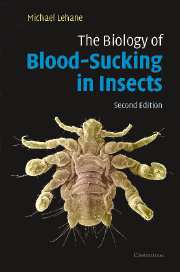Book contents
- Frontmatter
- Contents
- List of tables
- List of boxes
- Preface
- Acknowledgements
- 1 The importance of blood-sucking insects
- 2 The evolution of the blood-sucking habit
- 3 Feeding preferences of blood-sucking insects
- 4 Location of the host
- 5 Ingestion of the blood meal
- 6 Managing the blood meal
- 7 Host–insect interactions
- 8 Transmission of parasites by blood-sucking insects
- 9 The blood-sucking insect groups
- References
- Index
8 - Transmission of parasites by blood-sucking insects
Published online by Cambridge University Press: 08 January 2010
- Frontmatter
- Contents
- List of tables
- List of boxes
- Preface
- Acknowledgements
- 1 The importance of blood-sucking insects
- 2 The evolution of the blood-sucking habit
- 3 Feeding preferences of blood-sucking insects
- 4 Location of the host
- 5 Ingestion of the blood meal
- 6 Managing the blood meal
- 7 Host–insect interactions
- 8 Transmission of parasites by blood-sucking insects
- 9 The blood-sucking insect groups
- References
- Index
Summary
Like all other organisms, blood-sucking insects have their own array of parasites. Many of these parasites are common to a range of different insects, blood-sucking and non-blood-sucking alike. Others are transmitted between the vertebrate host and the insect and so are peculiar to blood-sucking insects, and the parasites normally depend on the blood-sucking habit for their existence. In line with the approach taken in this book, it is the relationships between blood-sucking insects and this latter group of parasites on which I will concentrate in this chapter.
Transmission routes
Table 8.1 shows that blood-sucking insects are responsible for the transmission of many important disease-causing organisms. At its simplest, transmission may involve the insect as a mechanical bridge between two vertebrate host species. At its most complex, transmission involves an obligatory period of replication and/or development by the parasite in the vector insect. A division is often drawn between ‘mechanical’ and cyclical or ‘biological’ transmission.
Mechanical transmission is said to occur when the blood-sucking insect is no more than a flying pin, transferring pathogens from one vertebrate host to another on contaminated mouthparts. Relatively little work has been carried out on the relationships grouped together as mechanical transmission and the possibility of more complex interactions should not be ignored. For example, it has been suggested, on the basis of epidemiological evidence, that some mechanism for the concentration of parasites in the vector's mouthparts may occur in the mechanical transmission of trypanosomes such as Trypanosoma vivax viennei and T. brucei evansi (Wells, 1982).
- Type
- Chapter
- Information
- The Biology of Blood-Sucking in Insects , pp. 150 - 201Publisher: Cambridge University PressPrint publication year: 2005
- 1
- Cited by



